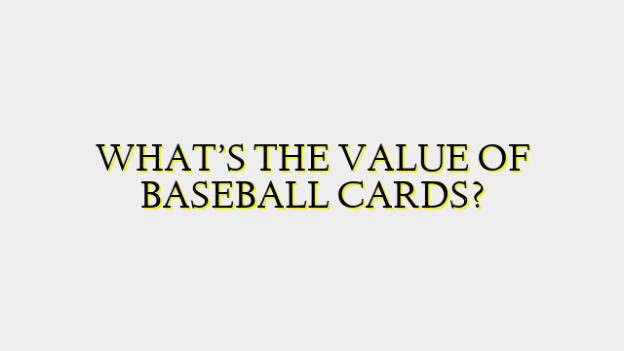The value of baseball cards can vary widely depending on many factors. Some of the main things that determine the value of a card include its condition, the player featured on the card, the card’s year of issue, and its scarcity or rarity.
A card’s condition is often the biggest determinant of its value. The condition of older cards from the pre-war era through the 1980s is especially important. Cards are graded on a scale from 1 to 10, with 10 being flawless mint condition. A card in a grade of 9 or higher will typically be valued much more than the same card in a grade of 5 or 6 which is considered worn. Even small bends, creases or edge wear can decrease a card’s value significantly. Professional grading from services like PSA, BGS or SGC adds consistency and objectivity to condition analysis.
The individual player on the card also impacts value greatly. Rookie cards or iconic cards featuring star players from history will usually demand higher prices. For example, a rare mint condition rookie card of Babe Ruth from 1914 could be worth over $2 million today. Other top player cards that bring high prices include Honus Wagner, Mickey Mantle, Ted Williams and Mike Trout. Conversely, cards of less notable players may only have value measured in dollars even in top condition. Finding key rookie cards of all-time greats is what drives the highest values.
Vintage cards from the early baseball card era between the 1880s-1920s can be especially valuable due to their age and limited surviving population. The oldest recognized baseball cards were issued in the late 1880s as cigarette or candy inserts. These early tobacco cards are considered some of the rarest and most valuable in the hobby. High grade examples from the T206 and T205 sets have topped millions at auction. From the 1950s through the 1980s, the most iconic and collectible issues were the modern pioneers of the mass-produced card boom like Topps, Fleer and Donruss.
Beyond condition and player, the specific card set and year of issue impacts value influenced by supply and demand. The smaller the original print run, the more scarce a card is over 100+ years of existing. Complete sets are worth more than loose singles. Flagship releases like Topps’ various decades of issues retain strong collector interest especially in the vintage period. Regional and promotional issues have their collector followings as well driving interest in oddball and niche categories over the decades which leads to higher values of scarce cardboard.
For modern cards post-1980s, the same factors of condition, player and scarcity still influence investment value. Rookie cards and stars of the current era may hold values measured in hundreds rather than thousands due to the sheer massive volume printed in the last few decades which makes true high-grade rarities more difficult to find. As an example, recent stars Mike Trout, Ronald Acuña Jr. and Juan Soto can still have rare rookie and prized parallel rookie refractor cards valued in thousands to tens of thousands in pristine condition due to their future hall of fame potential. The glut of modern products makes true seminal key rookie cards like the 1952 Topps Mickey Mantle more valuable on a per card basis.
With any collectible, condition is still king. The story behind the player can fuel nostalgia and command higher prices especially when rare early vintage cardboard is involved. Iconic players that make up baseball’s rich history and great Hall of Fame careers tend to see their cards increase in demand and value over generations as their legend cements. As supply decreases over a century of being in circulation and condition downgrades take cards out of the highest tiers, scarcity grows which will continue to drive up values of irreplaceable baseball artifacts from the earliest cardboard printings to multi-million dollar estimates for the most coveted pieces of 19th century collectibles.
The value of a baseball card is dependent on many interrelated factors but always comes down to the classic collectibles metrics of condition, player, scarcity and the exact card issue in question. While inexpensive as singe units in the early mass-production era, vintage pieces featuring the game’s all-time greats that survive in pristine quality can accumulate astonishing investment values as their rarity increases exponentially over time. The baseball card collecting marketplace will likely only continue appreciating these tangible remnants of the national pastime for generations to come.




